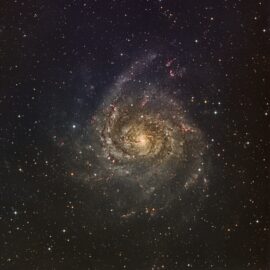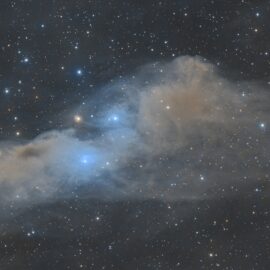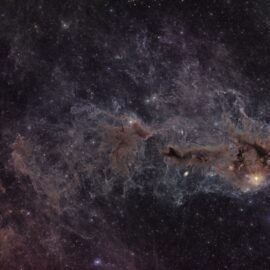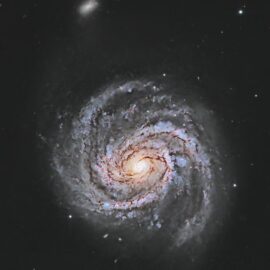In this blog, we use an Image of M100 to begin a description of how hydrogen (and other components) circulate and distribute around a spiral galaxy. This builds upon and takes another perspective on the series of posts describing the spiral galactic structure described on this website.
The Hidden Galaxy – Now you see it

IC342/Caldwell 5 – The Hidden Galaxy in LHaRGB Planewave CDK 12.5in; AP 1100GTO AE; QHY600M, – Baader Cmos Opt Broadband and 6.5nm Ha FiltersL: (50 x 180s, Bin 1, Gain 100); H: (29 x 720s Bin 1, Gain 100); R,G,B: (25,23,22 x 210s, Bin 1, Gain 100)Total integration time = 12.4 hrs (Feb 10-12, 2025) Maple Bay, BC, Canada For full resolution, downloadable image, visit my gallery at Victoria RASC Zenfolio or Astobin The Hidden Galaxy gets its name from its position in the sky, near the Milky Way and partly obscured by our galaxy’s dust. If not for the dust, IC342 would be visible with the naked eye and occupy about the same size as the moon. In reality
Its Supersonic! – But it’s complicated

The massive explosion of a supernova sends material (and light) outwards in all direction, at velocities greater than the speed of sound. The speed of sound is another way of saying the speed that pressure or density waves can travel or disperse through the medium that it is moving through. The particles ejected by the supernova are moving so fast and so much momentum that they don’t disperse but act like a moving wall of material, bulldozing and sweeping up any additional material in its path. Along the way, the particles that make up this moving wall, or shock front involves a lot of friction between particles so that it heats up to extreme temperature (million of degrees) and the wall emits light that we see as the remnants or remains of a supernova.
This wall, known as a shock-front, eventually runs out of momentum due to is expanding spherical geometry and sharing of momentum, but remains visible to our cameras long afterwards, until it fades through cooling. The patterns of emitted light are both beautiful and distinctive from other subsonic flow patterns, and these patterns enable us to identify these objects as supernova remnants. or leftovers from the supernova explosion.
More than Dust in the Wind

There is no deny that the dark nebula, LDN 534, makes an interesting target for astrophotography. It has all the earmarks of sky clouds being transformed by the wind. In fact it is likely a section of molecular cloud ripped out of the spiral arms, and being eroded by the winds of ISM. Unlike star fields that appear like foggy light that gets more disperse as concentration drops, the eroded molecular cloud seems to be much more wispy and reluctant to yield its integrity. Undoubtedly the hydrogen molecules do yield to the wind, disassociating to become atoms while the dust gets dispersed. We are lucky in this one, as a few stars make some nice blue reflections. In other cases, the eroded molecular cloud forms very coincidental shapes – included some naturally streamlined ones.
A Rotting Fish tells no tails

In this website’s second look at the Rotten Fish dark nebula, I wanted to bring home the concenpts involved in star nucleation. In case you were wondering, the answer is yes, star formation can happen in clouds not emitting Halpha light, even though we can certainly assiciate Haspha with star cluster / stellar nurseries. The answer lies in the mechanism of pressure buildup at points allowing diatomic molecular hydrogen and dust to nucleate a star. In both cases, dust provides the necessary cold temperature in addition to critical point temperature suppression. However, in the case of a dark cloud, the pressures required to nucleation is based on cloud turbulence alone, while stellar nursery clouds are aided in pressure build-up by stellar winds. It seems from images, that star formation in clouds is much more sporadic, while star clusters are more likely to be formed in stellar nurseries shining in Halpha light.
The Whirlpool Galaxy (M51) – In for Questioning

The M51 Galaxy or “The Whirlpool Galaxy” definitely strikes an awsome pose, with its two apparent “centres”, and multiple star fuzzies emanating from its extremes. I decided to get all Sherlock Holmesy on it in my desire to figure out what was going on. Yes it is two glalaxies interacting, but what is the nature of this interaction. What happened to its bottom arm? – it looks like it was bitten off. The upper arm looks more intact, but also exhibiting Halpha starburst too. Is the bottom of the galaxy connected to the top with stars circling the left hand side? Can infrared light help us? Can it potentially reveal something? I recommend reading more to find out.
Stars are born – Have a Cigar

In an everyday spiral galaxy (ho hum?), every effort is made by the galaxy itself to minimize the amount of energy wasted on forming turbulence of dust and hydrogen. As a result, areas of intense star formation in a regular spiral is usually restricted to a discrete points along the spiral arms where ISM and molecular cloud rub against each other to create the turbulence. These limited areas of star formation are seen as patches of bright red Halpha emissions. In this image of the Cigar Galaxy, it is evident that something has thrown “a wrench/spanner into the works” and created a hell of lot of turbulence, resulting in a fireworks display of red Halpha. When this occurs, stars are created at a very high rate and we reclassify such galaxies as “starburst” glaxies and the Cigar is one of them. Still, the original stars and dust lanes of this once regular spiral can be made out.


